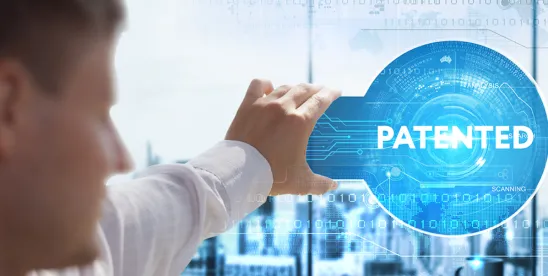On May 10, 2024, the United States Patent and Trademark Office (“USPTO”) published a new proposed rule that would require when a patent applicant submits a terminal disclaimer to obviate non statutory double patenting that the applicant agrees:
that the patent in which the terminal disclaimer is filed, or any patent granted on an application in which a terminal disclaimer is filed, will be enforceable only if the patent is not tied and has never been tied directly or indirectly to a patent by one or more terminal disclaimers filed to obviate nonstatutory double patenting in which: any claim has been finally held unpatentable or invalid as anticipated or obvious by a Federal court in a civil action or by the USPTO, and all appeal rights have been exhausted; or a statutory disclaimer of a claim is filed after any challenge based on anticipation or obviousness to that claim has been made.
The USPTO proposed this rule to prevent inventors from attempting to receive multiple patents directed to “obvious variations” of an invention. The USPTO believes that this proposed rule will deter anticompetitive behavior and promote innovation by “allowing a competitor to avoid enforcement of patents tied by one or more terminal disclaimers to another patent having a claim finally held unpatentable or invalid over prior art.”
Currently, when a terminal disclaimer is filed to obviate nonstatutory double patenting, a patent applicant is disclaiming any overlapping subject matter with an already existing patent owned by the patent applicant and is designed to prevent a patent applicant from improperly extending a patent’s term beyond its statutory limit. If a patent challenger wants to invalidate a family of related patents connected through terminal disclaimers, the patent challenger must invalidate each patent individually. Under the proposed rule, when a patent challenger is challenging a patent family, the patent challenger would need to successfully invalidate only one claim of a patent to invalidate that patent and any related patent that is tied to the invalidated patent through a terminal disclaimer.
On July 9, 2024, public comment closed for the proposed USPTO rule. Over 350 public comments were submitted giving feedback on the proposed rule. The public commentors’ opinions ranged from supporting the USPTO’s proposed rule to arguing against the USPTO’s proposed rule. Those submitting comments included private individuals, practicing attorneys, trade and policy organizations, and corporations.
Those against the proposed rule raised many concerns. The main issue with the proposed rule was the concern about the consequences of having a single patent claim invalidating an entire patent family. Other concerns raised included the potential of increased cost during patent prosecution and concerns about the potential to hurt small businesses by incentivizing companies to invalidate one claim instead of licensing patents.
Additionally, others argued that the USPTO does not have the authority to promulgate the proposed rule and that the USPTO is exceeding its statutory authority. For example, former USPTO directors Andrei Iancu, David Hirshfeld, David Kappos, Laura Peter, and Russell Slifer submitted a joint comment against the proposed rule noting many issues with the proposed rule including noting that the proposed rule would “render unenforceable entire patents if a single claim in a different patent is found to be invalid,” that the “proposal hands a powerful cudgel to infringers,” and that the USPTO is “evidently attempting to significantly deter, if not eliminate, continuations practice– a right that inventors are given by statute.”7 Others submitting comments against the rule included the American Intellectual Property Law Association and the American Bar Association Intellectual Property Law Association.
Those supporting the USPTO’s proposed rule argued that the proposed rule would promote competition and lower the cost to consumers by removing unnecessary patents and those supporting the rule believe that it allows smaller businesses to compete with larger corporations who are using “gamesmanship” to receive unmeritorious patents. For example, the Federal Trade Commission (“FTC”) issued a public comment supporting the USPTO’s proposed rule. In the support of the rule, the FTC explained that terminal disclaimers are used to “overcome the USPTO’s rejection of patent claims that are essentially the same as those in an existing patent,” that “[t]he use of terminal disclaimers linking similar patent claims can exacerbate the exclusionary impact of patent thickets by forcing potential market entrants to incur the high cost of challenging multiple duplicative patents,” and that “[t]he [FTC] believes the proposed rule will reform terminal disclaimer practice in a manner that reduces gamesmanship by patent holders, as well as the number, size, and impact of patent thickets. Intellectual property policy that promotes competition and market entry will foster vibrant markets that promote innovation and lower prices for businesses and consumers.”
Administrative Deference
While public comment was open for the proposed USPTO rule, the Supreme Court issued its decision in Loper Bright effectively eliminating Chevron deference for administrative agency action. The Supreme Court’s decision in Chevron, required courts to give “Chevron deference” to an agency’s administrative interpretation of a statue if the agency’s interpretation of an ambiguous statute was “rational” or “reasonable” and Congress had not spoken directly on that issue. However, in Loper Bright the Supreme Court found that Chevron deference “defied the command” of the APA and violates the court’s responsibility to interpret statutes and decide questions of law. This now means that Skidmore Deference will apply. Skidmore Deference means courts should judge an agency’s actions based on “the thoroughness evident in [an agency’s] consideration, the validity of its reasoning, its consistency with earlier and later pronouncements, and all those factors which give it power to persuade, if lacking power to control.” Skidmore v. Swift & Co., 323 US 134. 140 (1944)
The PTO’S primary statutory authority for rule making comes from 35 USC Section 2(b)(2), which provides that the USPTO “may establish regulations, not inconsistent with law, which—(A) shall govern the conduct of proceedings in the Office. . . .” The Federal Circuit years before Loper Bright issued already found that the PTO’s rulemaking authority authorizes them to create regulations regarding proceedings at the PTO and does not give the PTO the authority to issue substantive rules. See, e.g., Merck & Co., Inc. Kessler, 80 F.3d 1543, 1549-50 (Fed. Cir. 1996) (emphasis in original) (finding that the USPTO’s rulemaking authority authorizes the USPTO to create regulations regarding “the conduct of proceedings at the [PTO]” and “it does NOT grant the Commissioner the authority to issue substantive rules. . . . Thus, the rule of controlling deference set forth in Chevron does not apply.”); Animal Legal Defense Fund v. Quigg, 932 F.2d 920, 930 (Fed. Cir. 1991).
Therefore, with the stricter standard when judging agency action and the Federal Circuit finding the rule making authority for the PTO limited to proceedings at the PTO, it became likely that the proposed rule would not be passed. If it had been passed, the courts would have invalidated it, finding that the PTO did not have authority to pass such a rule.
USPTO Drops Proposed Rule Change
It appears that the vast number of submitted comments has indeed influenced the USPTO’s proposed rule. On December 4, 2024, the USPTO announced that it would be withdrawing its proposed terminal disclaimer rules. In explanation for the withdrawal, the USPTO cited to “resource constraints” as their reason for withdrawing the proposed rule and thanked those who had submitted comments.
Taking into consideration the recent Supreme Court case law along with the public comments, it may be that the USPTO felt that (1) it now lacked the administrative authority to issue such a rule or (2) the numerous comments against the regulations persuasively argued against the regulations. Regardless of its reasons, Congress continues to raise concerns and create legislation targeting “patent thickets,” and companies should still be aware of possible new regulations and laws that could change the current terminal disclaimer landscape. Furthermore, the case law on terminal disclaimers continues to change and those implications need to be considered as well.




 />i
/>i

